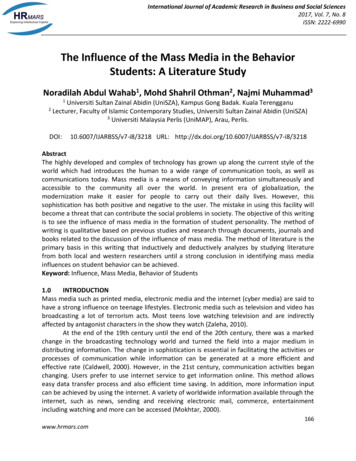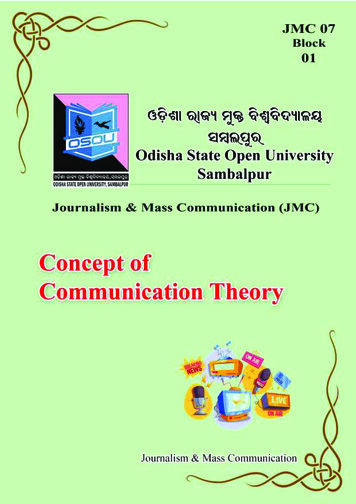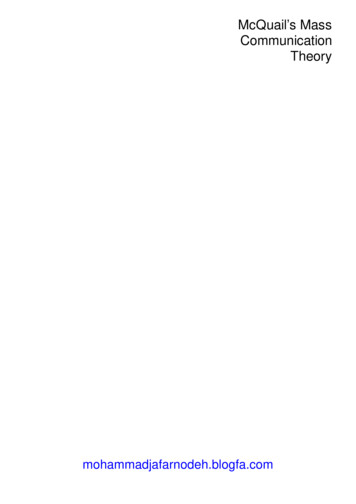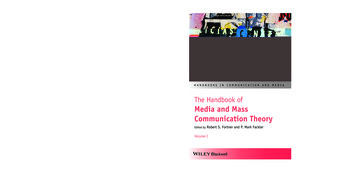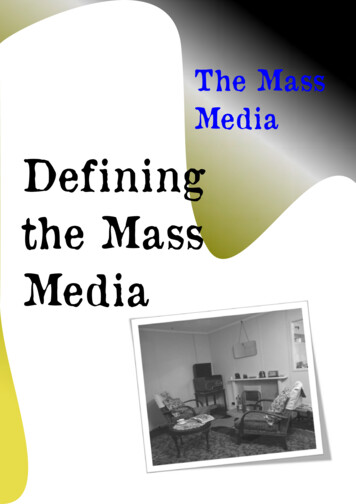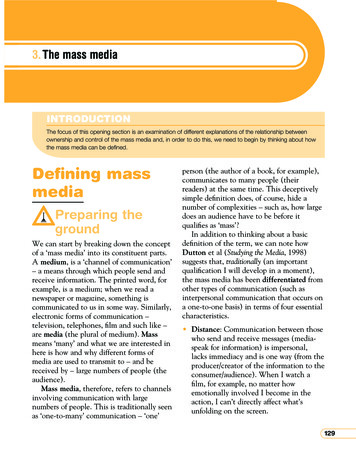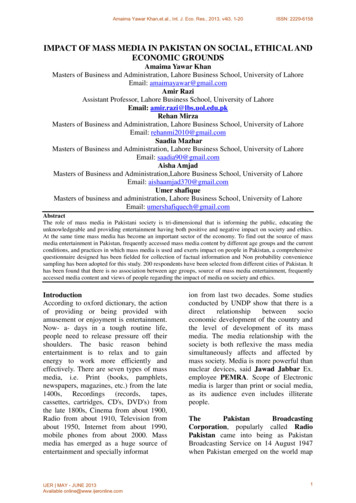
Transcription
Amaima Yawar Khan,et.al., Int. J. Eco. Res., 2013, v4i3, 1-20ISSN: 2229-6158IMPACT OF MASS MEDIA IN PAKISTAN ON SOCIAL, ETHICAL ANDECONOMIC GROUNDSAmaima Yawar KhanMasters of Business and Administration, Lahore Business School, University of LahoreEmail: amaimayawar@gmail.comAmir RaziAssistant Professor, Lahore Business School, University of LahoreEmail: amir.razi@lbs.uol.edu.pkRehan MirzaMasters of Business and Administration, Lahore Business School, University of LahoreEmail: rehanmi2010@gmail.comSaadia MazharMasters of Business and Administration, Lahore Business School, University of LahoreEmail: saadia90@gmail.comAisha AmjadMasters of Business and Administration,Lahore Business School, University of LahoreEmail: aishaamjad370@gmail.comUmer shafiqueMasters of business and administration, Lahore Business School, University of LahoreEmail: umershafiquech@gmail.comAbstractThe role of mass media in Pakistani society is tri-dimensional that is informing the public, educating theunknowledgeable and providing entertainment having both positive and negative impact on society and ethics.At the same time mass media has become an important sector of the economy. To find out the source of massmedia entertainment in Pakistan, frequently accessed mass media content by different age groups and the currentconditions, and practices in which mass media is used and exerts impact on people in Pakistan, a comprehensivequestionnaire designed has been fielded for collection of factual information and Non probability conveniencesampling has been adopted for this study. 200 respondents have been selected from different cities of Pakistan. Ithas been found that there is no association between age groups, source of mass media entertainment, frequentlyaccessed media content and views of people regarding the impact of media on society and ethics.IntroductionAccording to oxford dictionary, the actionof providing or being provided withamusement or enjoyment is entertainment.Now- a- days in a tough routine life,people need to release pressure off theirshoulders. The basic reason behindentertainment is to relax and to gainenergy to work more efficiently andeffectively. There are seven types of massmedia, i.e. Print (books, pamphlets,newspapers, magazines, etc.) from the late1400s, Recordings (records, tapes,cassettes, cartridges, CD's, DVD's) fromthe late 1800s, Cinema from about 1900,Radio from about 1910, Television fromabout 1950, Internet from about 1990,mobile phones from about 2000. Massmedia has emerged as a huge source ofentertainment and specially informatIJER MAY - JUNE 2013Available online@www.ijeronline.comion from last two decades. Some studiesconducted by UNDP show that there is adirectrelationshipbetweensocioeconomic development of the country andthe level of development of its massmedia. The media relationship with thesociety is both reflexive the mass mediasimultaneously affects and affected bymass society. Media is more powerful thannuclear devices, said Jawad Jabbar Ex.employee PEMRA. Scope of Electronicmedia is larger than print or social media,as its audience even includes n, popularly called RadioPakistan came into being as PakistanBroadcasting Service on 14 August 1947when Pakistan emerged on the world map1
Amaima Yawar Khan,et.al., Int. J. Eco. Res., 2013, v4i3, 1-20as a new country. At independencePakistan possessed three radio stationsat Dhaka(establishedin1939), Lahore (1937)and Peshawar (1936) and it is the result oftremendous growth of mass media that ,there are at least 106 licensed FM radiostation and a countless illegal FM stationsmostly operated by various madrassas. OnNovember 26, 1964 the first officialtelevision station commencedtransmission broadcasts fromLahore, followed by Dhaka in 1965 (thenthe capital of East Pakistan). A third centerwasestablishedin RawalpindiIslamabad in1965 and the fourth inKarachiin1966.Latercentersin Peshawar and Quetta were establishedby 1974. We now have 90 TV channelsbesides 28 foreign channels vying forPakistani audience.The Internet in Pakistan has beenavailable since the early 1990s andaccording to statistics of ITU 10.4% of thepopulation (as of June 2009) is usinginternet in Pakistan. Reportedly, there areover 20 million internet users and threemillion bloggers in Pakistan. With overfour million Pakistani users on Facebook,Pakistan is ranked 26th in the world. Theinternet and mobile penetration rates in thecountry are 23.42% and 60.4%respectively. Considering these statistics,technology and ultimately, social mediacan shape the future of the country.Psychologically, mass media is the need ofevery individual. Impact of mass mediamay be positive or negative on social,economic and ethical grounds, because itdepends on the mentality of the contentcreator that what message he is deliveringto the audience, and also on the mentalityof the audience, that what type of mindsetdoes each individual have. Mediainformation should be true and should notbe moral less. Everything should beaccording to Islam and should not crossthose limits which ALLAH has set inQuran and Hadith.IJER MAY - JUNE 2013Available online@www.ijeronline.comISSN: 2229-6158Mass Media has become a major sector ofeconomy over the last 15 years. The mediain fact is providing support to all sectors ofeconomy and development in terms ofconnectivity. It is a major vehicle forsharing information on diverse areas ofintervention.Objectives Of The Study1. What is the source of mass mediaentertainment of Pakistani populationaccording to age group?2. Which media content is frequentlyaccessed by different age groups?3. What is the impact of mass media inPakistan on social and economic andethical grounds?4. What are the views and opinions ofdifferent age groups regarding the impactof mass media in Pakistan?Literature ReviewAkbar, M.W. (2009).Media andtransmission of culture are interrelatedfactors. Media is a strong carrier ofcultural values and norms. Americanmedia has upper hand on rest of the worldtherefore Muslim countries should protectculture from foreign invasion. The must bean advisory committee of scholars, mediaexperts, ulemas, and professors of mediastudies who will make laws to defend thenegative effects of media. Islamic valuesmust be advertise and develop throughmedia. Vulgar songs, the usury, interest,music must be forbidden on media.Khan, A.N., Khalid, S., Khan, H.I. andJabeen, M. (2011). It is impossible toescape pervading influence of mass media.A large proportion of individuals had highamounts of media exposure more in menthan in women. In developing country likePakistan high media exposure has astatistically significant negative effect onbody image dissatisfaction of younguniversity students.Akbar, M.W., Raza, R.R., Numan, W.D.,Zai, N.A. (2013).Media organizations arerazors sharpened at both ends having2
Amaima Yawar Khan,et.al., Int. J. Eco. Res., 2013, v4i3, 1-20baneful effect on the audience. It isnecessary to formulate a code of ethics formass media. Media should refrain fromcausing damage to reputation of a personor institution. Media professionals shouldabide by the principles of ethics inperforming their duties. Mass media is adouble edged sword of any society havingboth positive as well as negative effectsdepending on the contents.Sabir, M. (2011). The impact of Pakistanimedia is wholesome on ion and even religion. The media ispowerful enough to manipulate the publicopinion and behavior and after theinduction of private T.V channels free oftotal government control, a phenomenaltransformation is insight resulting inpowerful media impact on the publicopinion. The ongoing scenario has been faraway from the norms and the principles ofa responsible journalism and necessitatesthe need for appropriate capacity buildingof the editors and the anchor-persons.Akhtar, W., Abbasi, A.S., Umer, S.(2011).This article is about the lack ofethicsinvolvedinadvertisementcampaigns in Pakistan, which conflict withthe Islamic Shariah, and the discomfort ofcustomers or consumers who view or reador hear about advertisement campaignsthat show nudity and sexist images to thepublic and portray negative messages.Cultural norms and values of society playan important role in shaping the attitudesof its people. Organizations that aremaking use of indecent language, nudity inadvertisements for marketing theirproducts in Pakistan are creatingoffensiveness in the minds of consumersfor their products.Sabir, M. (2012). History shows thatPakistani media has been controlled bystate. Media is a strong agent of changebut its change depends on the broadcastcontent. Media has been able to influencethe cultural, social and political perceptionIJER MAY - JUNE 2013Available online@www.ijeronline.comISSN: 2229-6158of Pakistani people. The major constraintand limitation of media are personalinterest, corruption, political affiliationsand monetary benefits and due to theseconstraints Pakistani media is more likeagenda following than agenda setting.Method and Procedure of the StudyNature of the StudyThe nature of the study is descriptive. Itinvolves collection of data, testinghypothesis, answering of key questionsrelating to social, cultural, ethical andeconomic issues. This type of research isconcerned with conditions that exist,practices that prevail, point of views orattitudes that are held, effects that are feltand trends that are emerging.SamplingTechniqueandCharacteristics of SampleNon probability convenience sampling hasbeen adopted for this study. 200respondents have been selected fromdifferent cities of Pakistan to providerequisite information on questionnaire,designed for this purpose.ToolsofCollectionofData(Questionnaire)A comprehensive questionnaire designedhas been fielded for collection of factualinformation about the current conditions,and practices in which mass media is usedand exerts impact on people in Pakistan.Hypothesis:H1: There is no association between agegroup and source of mass media content.H2: There is no association between agegroup and frequently accessed mass mediacontent.H3: There is no association between viewsregarding impact of mass media on societyand ethics in Pakistan and age groups.Results9.3 % people get most entertainment fromprint media, 3.7% from recordings, 1.9%3
Amaima Yawar Khan,et.al., Int. J. Eco. Res., 2013, v4i3, 1-20from cinema, 20.4% from television, 50%from internet, and 14.8% from mobileTable-1ISSN: 2229-6158phone. (Table- 1)Distribution Of Mass Media Source Of Entertainment In Pakistan OfAge Group 4.8541006.8 % people get most entertainment from print media, 4.1% from recordings, 12.2% fromcinema, 5.4% from radio, 14.9% from television, 47.3% from internet, and 7% from mobilephone. (Table- 2)Table-2 Distribution Of Mass Media Source Of Entertainment In Pakistan OfAge Group tal%f%f%47.379.57410020 % people get most entertainment from print media, 2.9% from recordings, 5.7% fromradio, 34.3% from television, 31.4% from internet, and 5.7% from mobile phone. (Table- 3)Table-3 Distribution Of Mass Media Source Of Entertainment In Pakistan Of AgeGroup .73510010.8 % people get most entertainment from print media, 2.7% from recordings, 8.1% fromcinema, 2.7% from radio, 27% from television, 37.8% from internet, and 4% from mobilephone. (Table-4)IJER MAY - JUNE 2013Available online@www.ijeronline.com4
Amaima Yawar Khan,et.al., Int. J. Eco. Res., 2013, v4i3, 1-20Table- 4PrintfISSN: 2229-6158Distribution Of Mass Media Source Of Entertainment In Pakistan OfAge Group (40 And Above)recordings%f4 10.8 1cinemaradiotelevision internet%f%f%f%f2.738.112.7 102714%Mobilephonetotalff37.8 4%%10.8 37 10018.5% Pakistanis like to access Islamic content, 35.2% like to access informative content,44.4% like to access entertaining content and 1.9% like to access other content. (Table-5)Table-5 Distribution Of Frequently Accessed Mass Media Content ByAge Group %f%f%f%1018.51935.22444.411.95410024.3% Pakistanis like to access Islamic content, 36.5% like to access informative andentertaining content and 2.7% like to access other content. (Table-6)Table-6 Distribution Of Frequently Accessed Mass Media Content ByAge Group %f%f%f%1824.32736.52736.522.77410022.9% Pakistanis like to access Islamic content, 37.1% like to access informative andentertaining content and 2.9% like to access other content. (Table-7)Table-7 Distribution Of Frequently Accessed Mass Media Content AmongAge Group %f%f%f%822.91337.11337.112.935100IJER MAY - JUNE 2013Available online@www.ijeronline.com5
Amaima Yawar Khan,et.al., Int. J. Eco. Res., 2013, v4i3, 1-20ISSN: 2229-615824.3% Pakistanis like to access Islamic content, 27% like to access informative content and48.6% like to access entertaining content. (Table-8)Table-8 Distribution of frequently accessed mass media content byAge group (40 and f%f%f%924.31027848.6--37100Social and Ethical ImpactThe role of mass media in Pakistanisociety is tri-dimensional that is informingthe public, educating the unknowledgeableand providing entertainment. A surveyconducted by Gilani Research Foundation,which carried out by Gallup Pakistanrevealed that more than half (52%) of allPakistanis consider media to be a source ofawareness, while 29% believed otherwise.Mass media has given each of us aplatform to voice our opinions on differentsocial and political issues and shareinformation with one another. SocialMedia has enabled the PYA (PakistanYouth Alliance) and other like-mindedgroups to share their experiences, gaincredibility and appreciation from other andhas removed our dependence on statecontrolled flow of information. Youthhave the opportunity to comment on eventhose topics which have long beenconsidered taboo. Pakistani media is veryvibrant and has become the most powerfulin changing opinions and views ofPakistanis. Discussion programs are beingarranged on television and radio onsubjects such as death, violence, drugs,morality, human relationships, the womenliberation movement, politics, religion andculture. As watch dogs the media keeps aclose watch on the misdeeds and wrongdoings of government and report to themasses. Movies, dramas, documentariesand programs which promote Islamic andeastern culture and convey message ofIJER MAY - JUNE 2013Available online@www.ijeronline.compeace, harmony, unity, love, care have avery positive impact on society and ethics.Media supports democracy by bringing outthe democratic norms and inculcating thesame in the general public / polity.Providing live coverage of parliamentproceedings, activities of politicians,programs on democracies are few of theexamples. On the other hand media hasalso negative impact on Pakistani societyand ethics. The media with their rootlessculture have been diffusing a culture ofnuclear families and neo-local families.Pakistani society is experiencing theerosion of practical religion and thetendency is towards greater ritualism.Sometimes the information reported bymedia is not authentic from every angleandmisrepresentsthesituation.Misleading messages divert youngPakistani minds towards wrong path.Wrong interpretation of messages andnews create further unrest and violence incase of extreme situations. The mediaplays an integral role in adolescentdevelopment. Some 76% of aggressiveand violent behavior was ng to a study. Students of Pakistanhighly involved in the social media as theresearch was being published by BBCnews unveiled this fact that 67% of thetotal respondents of face book comprisedof youth and students, so this complimentthe fact that students have more focus andrelation to this social media. The verycommon social media include Face book6
Amaima Yawar Khan,et.al., Int. J. Eco. Res., 2013, v4i3, 1-20and Twitter. The impact of social media onstudents is very much severe and if it is nottaken positively it will threaten the futureof millions of the students in Pakistan.According to an online IT portal ofPakistan it was indicated that “3.4 millionusers from Pakistan on Facebook aremale, while rest of 1.6 population isfemale. 76 percent of these users fromPakistan are aged between 18-34”. It issaid that “Twitter and Facebookinitiatives and comments have the powerto change people’s minds”. An untamedbeast if not regulated properly, it canunleash great havoc and pain in Pakistanisociety, as the violent videos on the webhas done permanent damage to many.Media is trying to make this century onlyfor those women with perfect bodies and itis one of the big factors why our wives,daughters, sisters and a lot more women inour society are at health risks. Women takethe issue of perfect body so serious thatthey risk their lives to achieve of what theybelieve is the media’s perception of aperfect body. Some negative outcomeincludes disorders and a lot of stress to ourwomen in the society. Pakistani channelsare promoting western culture more thanPakistani culture. Youth is moreinfluenced by it and is adopting their waysand few of which are actually unethicaland against our religious values andmorals. Other than this, Pakistani moviesand stage dramas are depicting a negativeimage of Pakistani culture. The stagedramas in the name of comedy areexploiting women’s image in a worse wayand humiliating their existence. Our mediahas hijacked the real issues of our societyand reported on fabricated issues. Anotheraspect of our electronic media is tocriticize too much against the country. Inthe Mumbai attack our media played anegative role. The media highlightedhuman rights violations in the country butfailed in playing its due role in opinionbuilding and educating the masses. It is aproven universal opinion that communitiesalways have won all their battles throughIJER MAY - JUNE 2013Available online@www.ijeronline.comISSN: 2229-6158the weapons of their social and culturalvalues. But Pakistani electronic media istrying to live under the death of social andcultural values as the majority of PakistaniTV Channels have a focused policy tocopy the Indian TV theories in order tograb more viewer ship for their financialinterests. Mass media in Pakistan areoperating in the society where norms andtraditions are based on the Islamic culture.In the developing society like ours, normsand values are not merely bearing theIslamic impact but have the rationalboundaries. In Pakistan the ethicalboundaries are partly similar to those usandsocialbackgrounds.In Pakistan,CPNE,APNS and PFUJ have developed the codeof ethics to follow. Mass media here isinvolved in the race of popularity, politicsand intension to break the news and couldnot manage to deliver the qualityinformation to the audience. Althoughmass media in Pakistan have intentionallyfollowed the ethical lines to disseminatethe credible information, which caused tothe gradual rise in the maturity in theattitude towards politics and the socialresponsibility. Media ethics kept thejournalism and cultural industries with theresponsibility to perform for thebetterment of society. But in the haste tobe first in delivering the news andinformation to the audience and for thesake of being popular among the viewers,readers and listeners, they compromisedthe media ethical values.Economic ImpactIn (2007-2008) the cable television sectoremployed 30,000 people, PTV employed6000 people, and Radio Pakistan hadmanpower of over 3000. The fastexpanding private electronic media in totalhas generated direct employment for morethan 50,000 people. The electronic mediagenerated revenue of Rs 8 billion per yearwhich was expected to grow to Rs 20billion by the close of the year 2007-08.7
Amaima Yawar Khan,et.al., Int. J. Eco. Res., 2013, v4i3, 1-20The advertising industry of Pakistan hasannual billings of more than Rs 3 billionper annum. Also the investment in printmedia is more than Rs 10 billion. MediumTerm Development Framework (MTDF)2005-10 envisaged an investment of Rs 5billion over five years in the Mass Mediasector. The media in fact is providingsupport to all sectors of economy anddevelopment in terms of connectivity. Theprivate sector investment so far is about Rs126 billion generating jobs for about1,50,000 people. Revenue of Rs 235,613million was generated by telecom sector in2007. This contribution has major impacton economy of Pakistan. The sector iscurrently contributing 2% GDP out of 7%to the Government of Pakistan. In the last2-3 years the telecom sector has attractedrecord inflows of FDI. During 2008-2009total revenue collected by the Governmentfrom telecommunication sector was morethan Rs. 100 billion. Telecom sectorrevenue grew by 20 percent in 2009 andgenerated Rs 327.8 billion in theeconomy. During 2009 Foreign DirectInvestment (FDI) stood at 815 milliondollar. Total investments in the sectorstood at 1.7 billion dollar and Telecomimports grew by 20 percent and reached1.6 billion dollar. By April 2010, therewere 97.6 million mobile phoneconsumers in Pakistan. Currently there areabout 3.5 million internet subscribers allacross in Pakistan whereas total userscrossed 17 million marks. Currentlyaround 3,002 cities are connected tointernet. It is the most documented sectorof the economy and a heavily taxed sectoras compared to others. Pakistan is on theverge of a telecom revolution and is by farthe most attractive sector in Pakistan interms of Foreign Direct Investmentcoming into thecountry. Sinceliberalization, over the past four years, thePakistani telecom sector has attracted morethan 9 billion in foreign investments. It isexpected that the trend of investment maycontinue in the next 5 years because largepotential market still exists in Pakistan andIJER MAY - JUNE 2013Available online@www.ijeronline.comISSN: 2229-6158all operators intend to grab their share.Revenues of the telecom sector during the2011-12, standing at Rs 363 billioncompared to the last year 344.2 billionshow an increase of 5.4 percent. Regardingtheimpactofinvestmentintelecommunication sector, it provesbeneficial for most of the countriesespecially the countries which want todevelop their economy. The inflow ofcapital in the form of FDI in telecomsector is a major benefit for them, then theincrease in tax revenues and jobopportunities in this sector also give theman edge for growth, especially indevelopingcountries. Telecommunicationdevelopment has a very strong impact onthe growth of an economy, but here soundplanning is required to fulfill therequirement of an economy, so thattelecom sector can play a role in industrial,agricultural, financial and manufacturingsector of economy. On the other hand useof internet makes the fastest source ofcommunication and generating morebusiness activities.The responses of Pakistanis in the agegroup (10-19) are as follows: (Table-9)35.2% people were” neutral” that theyhave high trust level on informationprovided by Pakistani media and 31.5%people” agree” that they have low trustlevel on information provided by Pakistanimedia. 31.5%people “agree” that theyignore a controversial program they havewatched on Television, 42.6% were“neutral” about criticizing a controversialprogram they have watched on Televisionand 37% people” agree” that they verifythe controversial program they havewatched on television. 29.6% people were“neutral” about the satisfaction with theperformance of Pakistani media. nt channels have a harmfuleffect on the ethics of Pakistani children.40.7% people “agree” that Indian andwestern thoughts are dominating Pakistanimedia. 46.3% people “disagree” thatPakistani media promotes Islamic culture8
Amaima Yawar Khan,et.al., Int. J. Eco. Res., 2013, v4i3, 1-20people” agree” that government must banunethical and vulgar content accessible toPakistanis.and values. 37% people” agree” thatMedia without necessary restrictions isresponsible for spreading vulgarity. 57.4%Table- 9ISSN: 2229-6158Distribution of impact of mass media in Pakistan on social and ethicalgrounds among age group (10-19)QuestionsStronglyAgreef%8 14.8Your trust level oninformationprovided byPakistani media ishigh8 14.8Your trust level oninformationprovided byPakistani media islow713When you watch acontroversialprogram on TV, youignore it.4 7.4When you watch acontroversialprogram on TV, youcriticize it.3 5.6When you watch acontroversialprogram on TV, youverify it.713You are satisfiedwith theperformance of ourmedia.25 46.3Internationalentertainmentchannels have aharmful effect on theethics of Pakistanichildren.22 40.7Indian and westernthoughts aredominatingPakistani media.IJER MAY - JUNE 2013Available greeTotalff%f12 22.2 19 35.2 11 20.447.454 10017 31.5 12 22.2 12 22.259.354 10017 31.5 12 22.5 15 27.835.654 10013 24.1 23 42.6 12 22.223.754 10020611.154 100%37%Disagreef%14 25.9 11 20.4%15 27.8 16 29.6814.8814.854 10015 27.8611.147.447.454 10015 27.871310 18.5--54 1009
Amaima Yawar Khan,et.al., Int. J. Eco. Res., 2013, v4i3, 1-20Pakistani massmedia promoteIslamic culture andvalues.Media withoutnecessaryrestrictions isresponsible forspreading vulgarity.Government mustban unethical andvulgar contentaccessible toPakistanis.35.6ISSN: 2229-615859.313 24.1 25 46.3814.854 10015 27.8 203710 18.5611.135.654 100823.711.954 10031 57.4 12 22.2The responses of Pakistanis in the agegroup (20-29) are as follows: (Table10)32.4% people were” neutral” that theyhave high trust level on informationprovided by Pakistani media and 31.1%people were” neutral” that they have lowtrust level on information provided byPakistani media. 40.5%people “agree”that they ignore a controversial programthey have watched on Television, 43.2%people “agree” about criticizing acontroversial program they have watchedon Television and 36.5% people were”neutral” that they verify the controversialprogram they have watched on television.32.4% people “agree” about thesatisfaction with the performance ofPakistani media. 41.9% people “stronglyagree” that international entertainmentchannels have a harmful effect on the14.8ethics of Pakistani children. 44.6% people“strongly agree” that Indian and westernthoughts are dominating Pakistani media.29.7% people were “neutral” thatPakistani media promotes Islamic cultureand values. 43.2% people” agree” thatMedia without necessary restrictions isresponsible for spreading vulgarity. 50%people” agree” that government must banunethical and vulgar content accessible toPakistanis.Table-10 Distribution of impact of mass media in Pakistan on social and ethicalgrounds among age group (20-29)QuestionsYour trust level oninformationprovided byPakistani media ishighStronglyAgreef7IJER MAY - JUNE 2013Available 74%10010
Amaima Yawar Khan,et.al., Int. J. Eco. Res., 2013, v4i3, 1-20Your trust level oninformationprovided byPakistani media islowWhen you watch acontroversialprogram on TV, youignore it.When you watch acontroversialprogram on TV, youcriticize it.When you watch acontroversialprogram on TV, youverify it.You are satisfiedwith theperformance of ourmedia.Internationalentertainmentchannels have aharmful effect onthe ethics ofPakistan children.Indian and westernthoughts aredominatingPakistani media.Pakistani massmedia promoteIslamic culture andvalues.Media withoutnecessaryrestrictions isresponsible forspreading vulgarity.Government mustban unethical andvulgar contentaccessible toPakistanis.ISSN: .845.422.774100The responses of Pakistanis in the agegroup (30-39) are as follows: (Table11)37.1% people ” agree” that they haveIJER MAY - JUNE 2013Available online@www.ijeronline.comhigh trust level on information provided byPakistani media and 31.4% people“disagree” that they have low trust level11
Amaima Yawar Khan,et.al., Int. J. Eco. Res., 2013, v4i3, 1-2060% people “strongly agree” that Indianand western thoughts are dominatingPakistanimedia.31.4%people“disagree” that Pakistani media promotesIslamic culture and values. 51.4% people“strongly agree” that Media withoutnecessary restrictions is responsible forspreading vulgarity. 77.1% people“strongly agree” that government mustban unethical and vulgar contentaccessible to Pakistanis.on information provided by Pakistanimedia. 31.4%people “disagree” that theyignore a controversial program they havewatched on Television, 45.7% people“agree” about criticizing a controversialprogram they have watched on Televisionand 28.6% people” agree” that they verifythe controversial program they havewatched on television. 28.6% people were“neutral” about the satisfaction with theperformance of Pakistani media. 65.7%people “strongly agree” that internationalentertainment channels have a harmfuleffect on the ethics of Pakistani children.Table- 11QuestionsYour trustlevel oninformationprovided byPakistanimedia is high.Your trustlevel oninformationprovided byPakistanimedia is low.When youwatch acontroversialprogram onTV, you ignoreit.When youwatch acontroversialprogram onTV, youcriticize it.ISSN: 2229-6158Distribution of impact of
group and source of mass media content. H. 2: There is no association between age group and frequently accessed mass media content. H. 3: There is no association between views regarding impact of mass media on society and ethics in Pakistan and age groups. Results . 9.3 % people get most entertainment from

